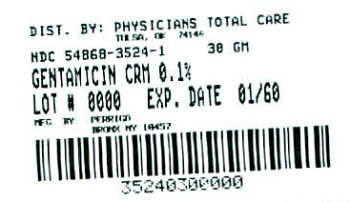Gentamicin Sulfate Dailymed
Generic: gentamicin sulfate is used for the treatment of Bone Diseases, Infectious Central Nervous System Infections Endocarditis Endocarditis, Bacterial Escherichia coli Infections Hypersensitivity Klebsiella Infections Proteus Infections Pseudomonas Infections Respiratory Tract Infections Staphylococcal Infections Peritonitis, Tuberculous Urinary Tract Infections Eye Infections, Bacterial Serratia Infections Skin Diseases, Bacterial Soft Tissue Infections Sepsis
Go PRO for all pill images
Rx Only
Description
Each gram of GENTAMICIN CREAM contains gentamicin sulfate equivalent to 1 mg of gentamicin base in a cream base of: methylparaben, butylparaben, stearic acid, cerasynt PA (propylene glycol monostearate), isopropyl myristate, propylene glycol, polysorbate 40, sorbitol solution and water. Each gram of GENTAMICIN OINTMENT contains gentamicin sulfate equivalent to 1 mg of gentamicin base in a base of: Light Mineral Oil and White Petrolatum, with 0.5 mg methylparaben and 0.1 mg propylparaben as preservatives.
Clinical Pharmacology
GENTAMICIN, a wide spectrum antibiotic provides highly effective topical treatment in primary and secondary bacterial infections of the skin. This product may clear infections that have not responded to other topical antibiotic agents. In impetigo contagiosa and other primary skin infections, treatment with a small amount of GENTAMICIN OINTMENT AND CREAM three to four times daily usually clears the lesions promptly. In secondary skin infections, the product facilitates the treatment of the underlying dermatosis by controlling the infection. Bacteria susceptible to the action of GENTAMICIN include sensitive strains of streptococci (group A beta-hemolytic, alpha-hemolytic), Staphylococcus aureus (coagulase positive, coagulase negative, and some penicillinase-producing strains), and the gram-negative bacteria, Pseudomonas aeruginosa, Aerobacter aerogens, Escherichia coli, Proteus vulgaris and Klebsiella pneumoniae.
Indications And Usage
Primary skin infections: Impetigo contagiosa, superficial folliculitis, ecthyma, furunculosis, sycosis barbae, and pyoderma gangrenosum. Secondary skin infections: Infectious eczematoid dermatitis, pustular acne, pustular psoriasis, infected seborrheic dermatitis, infected contact dermatitis (including poison ivy), infected excoriations, and bacterial superinfections of fungal or viral infections. NOTE: Gentamicin is a bactericidal agent that is not effective against viruses or fungi in skin infections. It is useful in the treatment of infected skin cysts and certain other skin abscesses when preceded by incision and drainage to permit adequate contact between the antibiotic and the infecting bacteria. Good results have been obtained in the treatment of infected stasis and other skin ulcers, infected superficial burns, paronychia, infected insect bites and stings, infected lacerations and abrasions and wounds from minor surgery. Patients sensitive to neomycin can be treated with GENTAMICIN, although regular observation of patients sensitive to topical antibiotics is advisable when such patients are treated with any topical antibiotic. GENTAMICIN CREAM is recommended for wet, oozing primary infections, and greasy, secondary infections, such as pustular acne or infected seborrheic dermatitis, and where a water washable cream preparation is desired. GENTAMICIN OINTMENT helps retain moisture and has been useful in infection on dry eczematous or psoriatic skin. GENTAMICIN CREAM and OINTMENT have been used successfully in infants over one year of age as well as in adults and children.
Contraindications
This product, GENTAMICIN OINTMENT AND CREAM is contraindicated in individuals with a history of sensitivity reactions to any of its components.
Precautions
Use of topical antibiotics occasionally allows overgrowth of nonsusceptible organisms, including fungi. If this occurs, or if irritation, sensitization, or superinfection develops, treatment with GENTAMICIN should be discontinued and appropriate therapy instituted.
Adverse Reactions
In patients with dermatoses treated with GENTAMICIN, irritation (erythema and pruritus) that did not usually require discontinuance of treatment has been reported in a small percentage of cases. There was no evidence of irritation or sensitization, however, in any of these patients patch-tested subsequently with gentamicin on normal skin. Possible photosensitization has been reported in several patients but could not be elicited in these patients by reapplication of gentamicin followed by exposure to ultraviolet radiation.
Dosage And Administration
A small amount of GENTAMICIN OINTMENT or CREAM should be applied gently to lesions three to four times a day. The area treated may be covered with a gauze dressing if desired. In impetigo contagiosa, the crusts should be removed before application of GENTAMICIN OINTMENT or CREAM to permit maximum contact between the antibiotic and the infection. Care should be exercised to avoid further contamination of the infected skin. Infected stasis ulcers have responded well to GENTAMICIN under gelatin packing.
How Supplied
GENTAMICIN CREAM is supplied in
15 gram tube NDC 54868-3524-0 30 gram tube NDC 54868-3524-1
Store at controlled room temperature 15°-30°C (59°-86°F).
MANUFACTUREDBY PERRIGOBRONX, NY 10457
1C800 RC J2
Relabeling of "Additional" barcode label by: Physicians Total Care, Inc.Tulsa, OKÂ Â Â Â Â Â 74146
Principal Display Panel
GENTAMICIN CREAM
30 gram

DISCLAIMER:
"This tool does not provide medical advice, and is for informational and educational purposes only, and is not a substitute for professional medical advice, treatment or diagnosis. Call your doctor to receive medical advice. If you think you may have a medical emergency, please dial 911."
"Do not rely on openFDA to make decisions regarding medical care. While we make every effort to ensure that data is accurate, you should assume all results are unvalidated. We may limit or otherwise restrict your access to the API in line with our Terms of Service."
"This product uses publicly available data from the U.S. National Library of Medicine (NLM), National Institutes of Health, Department of Health and Human Services; NLM is not responsible for the product and does not endorse or recommend this or any other product."
PillSync may earn a commission via links on our site

